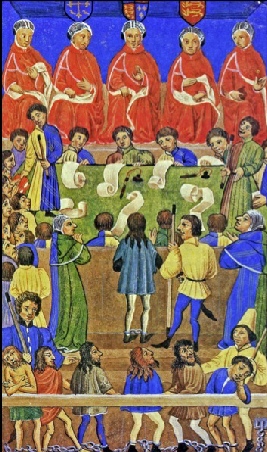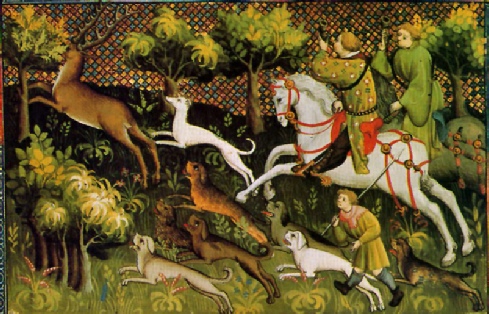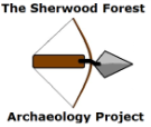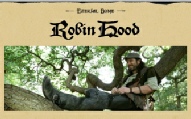Sherwood Forest in medieval times was an area of land subject to Forest Law.
The Forest Law protected Beasts of the chase (primarily deer) from being hunted, by anyone except the king unless he gave them permission.
It also protected the Woodland and habitat in which they lived.
It was therefore illegal to hunt deer or to chop down trees and underwood within a Forest.
The Forest law was another layer of administration that people had to obey.
The first surviving legal texts relating to the forest laws come from 1100. This is at the very start of the reign of Henry I
Offences included:
Clearing of land
Cutting of wood
Burning
Hunting,
Carrying of bows and spears in the forest
Loosing of livestock
There were also rules regarding:
The hambling of dogs
Discovery of hide or flesh
*Hambling of dogs meant the removal of claws to prevent the dog from hunting.
Law Enforcement:
Every forest in England was overseen by a Keeper.
This person was appointed directly by the king.
In Sherwood Forest the Keepership of the Forest was hereditary.
The De Caux and through marriage the D'Everingham families were hereditary keepers of the Forests of Nottinghamshire until 1286.
Following this the keepership was granted at the kings pleasure, and was usually given along with Stewardship of Nottingham Castle.
The keepers of the forest were responsible for policing the forest: they hired Foresters and agisters to act as a police force.
Foresters had the power to arrest people for infringements on the forest law. They patrolled the forest on horseback and on foot.
Agisters were tax collectors who administered rents and checked quotas relating to the grazing of animals (agistment) in the woods of the forest.
When someone had broken the law, a system of courts was required to punish the assailant.
Courts of the Forest:
There were a number of courts in the forest these included a small fines court -
The Attachment court was where judgment was passed on small cases of trespass on the vert (literally the ‘greenery’ -
In Sherwood Forest there were four such courts:
Linby,
Calverton,
Mansfield,
and Edwinstowe
They met every 40 days at these locations, and were sometimes called the 40 day courts.
The Attachment court officials were known as ‘Verderers’.
This was a Privileged role-
Verderers had to be landowners within the forest to qualify for the position.
There were usually 4 per forest, but in Sherwood there were 6.
The roll of the 1292-
green oak was usually valued at 6d
a dry oak at 4d
a sapling from 1d to 3d
and stubb, or dry trunk of a pollard tree at 2d.
Forest Eyre:
The largest and most serious court of the Forest was known as the ‘Forest Eyre Court’. This was a major affair and was held less frequently than the aforementioned Attachment court.
The Forest Eyres Courts oversaw the exacting of justice on larger and more serious breaches.
These included poaching, as well as larger breaches against the vert (literally the greenery -
The Forest Eyres were attended by itinerant justices, who were sent around the country from Westminster to ensure forest Law was upheld correctly in the Shires.
This is where the name ‘Eyre’ comes from: it is a Middle English term derived from the Old French word ‘eire’, which itself comes from Latin word ’iter’ meaning ‘journey’.
(from ‘A Law Dictionary: Or the Interpreter of Words and Terms: Used ... in the Common Or Statute Laws ... with an Appendix Containing ... the Antient Names of Places ... and ... Surnames …’‘ (Cowell, 1772))
In other words the court judges were itinerant and the court ‘journeyed’ around the country.
The courts were often named after the justices themselves,
So the 1187 forest Eyre was known as the Eyre of Geoffrey Fitzpeter.
The Eyre dealt with extracting fines and levies from larger breaches of the Forest law.
eg. In 1267 the Abbot of Rufford was charged with felling 483 oaks, for building purposes since the last Eyre.
The records for two of Sherwood Forests Eyre Courts survive in full. These are for 1287 and 1334.
There were two jurisdictions for the justices in Eyre for the country-
The Forest Eyre for Sherwood Forest was therefore administered by 'the Kings Justices in Eyre Yon side Trent'.
The 1287 Sherwood Forest Eyre Court

The 1287 Sherwood Forest Eyre Court took place on the morning of the feast of St Hilary (January 13th) in Nottingham.
Pleas of the Forest were heard before Sirs William De Vescy, Thomas de Normanvillle, and Richard de Creeping-
They were also heard before the Verders (viridarios) of the Forest:
Richard de Jort, William of Colwick, John of Annesley, Henry of Tinsley, William of Bevercotes and Ralph the Clerk of Mansfield (clericum de Mammesfeld).
And Foresters (forestarios):
Robert D’Everingham forester in fee (forestarium feodi)-
Walter of Winkburn the attourney of the justice of the forest , and under him William of Hastings, William de Sheffield (Schaffeud), William the Welshman (Waleys), Robert of Linby, Bate of Linby, Hugh of Mansfield and Henry son of Richard of Clipstone.
The court opened and heard a number of cases of trespass against the venison-
Including an offence committed in Sherwood Forest in 1279 'on the Friday next before Ascension Day in the seventh year of the reign of King Edward...'
'It is presented by Adam D'Everingham (hereditary keeper of Sherwood Forest) that Alan of Leverton, clericus foreste de Schirewod (the clerk of Sherwood Forest) with Robillard his page took a doe in the park of Clipston(e)... with a laparario ruffo (red greyhound)...'

Picture: Medieval hunting scene
The doe was eaten by the pigs in the park because it was taken so late at night it was too dark to find it…
A common problem presumably for illicit poachers!
Following his crime which along with killing the king's deer, must have included failing to 'hamble' his hound (removing of claws-
Maybe he spent time under the custody of 'William the Gaoler' who was one of the gaolers at Nottingham Castle around that time?
Maybe not though as he wasn't in gaol for too long receiving a ransom of half a mark sometime after...
His page Robillard did not show up and appears to have gone on the run
He was then exacted (his belongings seized-
The interesting fact here is that these men were not peasants struggling for food in the forest to avoid starvation. Many of the people caught poaching or caught chopping down trees were ordinary folk.
In this instance they were members of the Forest Administration itself! They were in the employment of the keeper of the Forest Adam D'Everingham.
Understanding their motives is a little harder.
Even harder still is to understand the motives of Robert D'Everingham -
... for poaching the King's deer!
The entry does at least show us that Forest Law affected people at all levels of society. The fact that people were willing to infringe upon these laws despite the risks, shows us the allure of hunting and poaching to people in medieval Sherwood Forest.
The court then proceeded to set out the following points:
1. The Verderers of Sherwood are to hold their court every 40 days into the small infringements against the vert (cutting down trees) and small pleas – as stated in the Charter of the Forest (the great charter of Magna Carta was first signed in 1215, it was followed by a separate Charter of the Forest in 1217). They were to present their findings on two court rolls to the Eyre-
It seems that the Justices in Eyre, and the King, believed that the local justices (verderers) were failing in their duties in upholding Forest Law.
Picture: the 1217 Charter of the Forest
2. All the demesne woods of the lord king (bosci domini regis -
His Mainour (that which he stole) is to be appraised by the foresters and verderers and he is to pay the amount it was worth to the verderers.
If a person is caught a second time trespassing against the vert-
If a person is caught a third time they will be locked up safely in the prison of the lord King at Nottingham until they can be brought before the justices in Eyre.
Being locked up was no relaxing time-
The Forest Eyres were not exactly regular so a wait at his majesty’s pleasure was not exactly pleasurable-
This may seem bad enough-
It was different for those living outside:
3. Anyone dwelling outside the forest caught felling trees in the demesne woods of the lord King also had to pay the amount it was deemed to be worth
His body was then to be submitted to prison (corpus suum committatur prisone) until he can be brought before the justices of the forest.
Strike one-
If he is found a second time then the same will happen.
If he is found trespassing against the vert for a third time he is to lose his horses with his cart, or his oxen with his wagon, or their price; and that price must be paid in full at the next verderers court or to the neighbouring township for the use of the lord king , so that the verderer or his heirs or the township may answer therefore to the lord king before the justices in Eyre.
Presumably losing a horse and cart or an oxen and wagon was almost terminal for your average medieval peasant!
4. If a person who lived in the forest was found taking small sapplings below the value of four pence they were to be tried before the verderes-
This entry lists ‘cutting saplings, branches or dry wood from oaks or hazels or thorns or a lime or an alder or a holly or such like trees...’
There are not many references to the types of trees available to peasants on the ground in the forest-
Entries 5 and 7 discuss the fines for escaping beasts of the plough (escapia aueriorium) which ended up in the woods of the king causing damage there.
Entry 6 states that ‘it is provided that no man in the future carry bows and arrows (arcus vel sagittas) in the forest outside the king’s highway, unless he is a sworn forester (forestarius iuratus).
The remaining entries list responsibilities of the regarders (those who check the boundaries) and foresters with regard to trespass in wood not belonging to the crown.
The forest Eyre of 1287 then, gives us a great insight into the adminsitration of Sherwood Forest and the application of Forest Law and its impact on the lives of the people in and around Medieval Sherwood Forest.
Pleas taken from: Turner G.J., 1901. Select Pleas of the Forest. Seldon Society.
(Andy Gaunt, first published 11/02/2012-
Click here for more ‘Stories from the Forest’…



Community Archaeology Nottinghamshire, Community Archaeology Derbyshire, Community Archaeology Leicestershire, Community Archaeology East Midlands, Mercian Archaeological Services Community Archaeology for Nottinghamshire, Derbyshire, Sherwood Forest, Leicestershire and the East Midlands. Community Archaeology Nottinghamshire, Community Archaeology East Midlands, Community Archaeology Leicestershire. Archaeological

The Forest Law & the 1287 Sherwood Forest Eyre Court
Award Winners 2016
for "Engaging people in the heritage, history & archaeology of Sherwood Forest".





Some funders and partners:
World-











The Future of Sherwood’s Past
Project page links:
-
-
-
-
-
-
-
-
The Sherwood Forest
National Nature Reserve Archaeology Survey
-
Long term Research at
King John’s Palace:
Ancient Royal Heart of Sherwood Forest
-
The Sherwood Forest Archaeology Training Fieldschool
-
“Scirwuda-
Ghost and Shadow woods of Sherwood Forest Project
-
Investigating Thynghowe Viking
Meeting Site
-
Searching for the
The Battle of Hatfield
-
-
Fieldswork at St Edwin’s Chapel
-
St Mary’s Norton-
-
Mapping Medieval Sherwood Forest
-
The Sherwood Forest LiDAR
Project
-
Warsop Old Hall
Archaeological Project
-
The Sherwood Villages Project:
Settlement Development in the Forest
-
-
-
Researching Edward IIs fortification at Clipstone Peel
-
-
-
-
The Cistercians of Rufford Project:
Settlement Development, Dynamics and Desertion.
-
Sherwood Forest Environmental Survey
-
World War II in Sherwood Forest -
-
World War I in Sherwood Forest -
-
About Medieval Sherwood Forest
-
Robin Hood and Sherwood Forest
-
-
-
-
-
-
-
-
-
-
-
-
Mercian Archaeological Services CIC (Community Interest Company)
An Independent Research Company, specialising in Training, Community Archaeology & Public Involvement.
Community Archaeology Nottinghamshire, Excavation, Research, Volunteering, Community Archaeology Derbyshire, Training, Social, Learning, Community Archaeology Leicestershire, Heritage, Involvement, Belonging, Knowledge sharing, Community Archaeology Lincolnshire, Topographic Survey, Talks and Presentations, Outreach, Archaeology Projects , Open Days, Schools, Finds Processing, Day Schools, Field Schools, Young People, Archaeology and History of Sherwood Forest, Pottery Research, Medieval, Roman, Prehistoric, Community Interest Company, Community Archaeology Nottinghamshire.
Community Archaeology in Nottinghamshire
Community Archaeology in Derbyshire
Community Archaeology in Leicestershire
Community Archaeology East Midlands
Community Archaeology in Lincolnshire
© Mercian Archaeological Services CIC 2019. Registered Business No. 08347842. All Rights Reserved.
Community Archaeology in Yorkshire
Project page links:
-
-
-
-
-
-
-
-
The Sherwood Forest
National Nature Reserve Archaeology Survey
-
Long term Research at
King John’s Palace:
Ancient Royal Heart of Sherwood Forest
-
The Sherwood Forest Archaeology Training Fieldschool
-
“Scirwuda-
Ghost and Shadow woods of Sherwood Forest Project
-
Investigating Thynghowe Viking
Meeting Site
-
Searching for the
The Battle of Hatfield
-
-
Fieldswork at St Edwin’s Chapel
-
St Mary’s Norton-
-
Mapping Medieval Sherwood Forest
-
The Sherwood Forest LiDAR
Project
-
Warsop Old Hall
Archaeological Project
-
The Sherwood Villages Project:
Settlement Development in the Forest
-
-
-
Researching Edward IIs fortification at Clipstone Peel
-
-
-
-
The Cistercians of Rufford Project:
Settlement Development, Dynamics and Desertion.
-
Sherwood Forest Environmental Survey
-
World War II in Sherwood Forest -
-
World War I in Sherwood Forest -
-
About Medieval Sherwood Forest
-
Robin Hood and Sherwood Forest
-
-
-
-
-
-
-
-
-
-
-
-